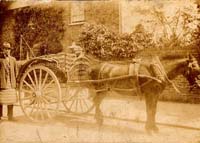Teddington – from farmland to town
Originally farming and pasture, the population of the village grew dramatically in the 19th c. with arrival of the railway

Teddington is not separately mentioned in the Domesday Book of 1086, being included with Hampton and Hampton Wick when the approximate total population for all three places was 200. It is estimated from Hearth Tax returns that the population of Teddington was around 250 by 1664. By the time of the census in 1801 the population was 699 for the parish, which covered an area of just over 1200 acres. After the arrival of the railway the population grew dramatically from 1183 in 1861 to 4063 in 1871, 6599 in 1881, 10052 in 1891 and 14037 in 1901. The population reached a peak of over 24000 in 1951, slipping back to something over 21000 in 1991, the same as 1921, due to the fall in the size of households.
At the time of the Enclosure in 1800 the land was largely open ground. There was farming in the eastern end of the parish and pasture along the riverside. At the western end was Teddington Common, part of Hounslow Heath, on which the poor collected fuel. This land was not suitable for cultivation but may have provided some grazing. The existing roads at that time were Kingston Road, High Street, Waldegrave Road (then Fry's Lane), Park Road and Shacklegate Lane.
The population exploded for two concurrent reasons. In 1861 the Manor of Teddington was put up for sale. The estate amounted to 480 acres by this time, a large proportion of the parish. The land was broken down into plots and sold mainly to builders and speculators. This quickly brought about the building of many new roads, such as Cambridge Road and Cambridge Crescent, which were at the heart of the old estate.
The other growth factor was the coming of the railway in 1863. The immediate impact was the arrival of large numbers of construction workers. The construction of the railway temporarily cut the village in two, for over two years, until the massive mound was constructed. This enabled construction of a road bridge over the railway track, linking High Street to Broad Street again. The completed railway brought many people to Teddington to buy or rent property. This combination of available land and good transport links accounted for the sharp rise in population. The number of houses increased from 212 to 3066 between 1851 and 1901. This was due in part to the availability of land, and was far larger than in the neighbouring villages. The total population of Hampton and Hampton Hill, for instance, was nearly three times the size of Teddington in 1851 but was less than half its size by 1901. Trams came to Teddington in 1903 and this improved transport links further.

Teddington set up a Local Board in 1867, becoming an Urban District Council in 1895, subsequently meeting in Elmfield House, which had recently been purchased. Unlike neighbouring areas, market gardening was never important in Teddington although there were some nurseries. R D Blackmore, the author, did have a market garden that grew fruit, including pears, peaches and grapes, but this was considered more of a hobby than a practical industry.



